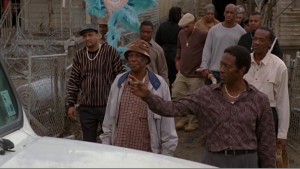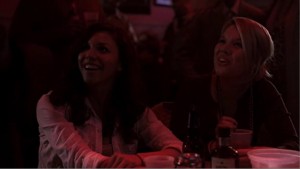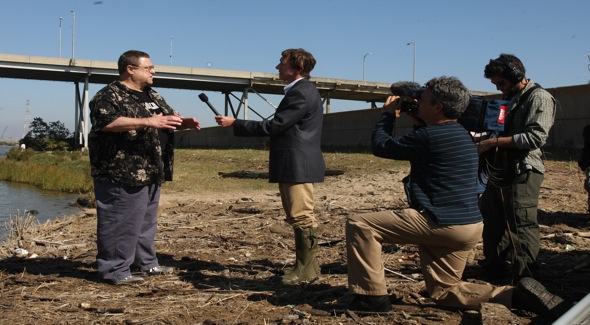“Treme” is like a park with a sign that says “Welcome” followed by a long list of “Do Not”’s.
—John McWhorter, “Please, Treme, I Beg You – Get Over Yourself”
You say you got a real solution
Well, you know,
We’d all love to see the plan
You ask me for a contribution
Well, you know,
We’re all doing what we can.
—The Beatles, “Revolution”
Antoine Batiste (Wendell Pierce), desperate for work, takes a gig playing his bone in a Bourbon Street club (Episode 2, “Meet De Boys on De Battlefront”). He winces when handed the number to call. When wandering down the tourist trap toward his gig, he runs into a fellow artist and lies about where he’s headed. “There’s still pride on Bourbon Street,” he’s told several times; it’s repeated like a rosary chant.
Earlier in that same episode, we formally meet Sonny (Michiel Huisman) and Annie (Lucia Micarelli), two street musicians hustling tourists for a little coin. A trio of college kids from Wisconsin, their cheeks ripe with baby fat, applaud them and leave tips. They mention that they’re in New Orleans rebuilding houses with their church group. “You ever even heard of the Ninth Ward before the storm?” Sonny asks. He bristles until Annie changes the subject, then offers to repair the offense by playing “When The Saints Go Marching In,” all the while harping on its fakeness. “You said ‘Saints,’ not us,” one of the college students points out, but Sonny’s too fired up to stop now.
(Don’t mind him, kids; Sonny’s an asshole.)
But the culmination of this attitude comes at the end of Episode 3 (“Right Place, Wrong Time”), when Albert Lambreaux (Clarke Peters) holds a service for the loss of his Indian troupe’s “wild man.” Lambreaux, his Indians and several Chiefs from other troupes gather outside the wild man’s home and begin a mournful yet vibrant dance. They’ve worked themselves into a riot when a big white bus labeled “KATRINA TOURS” lumbers down the road toward them. The driver rolls his window down and asks what’s going on, as several passengers (their faces obscured by tinted windows) snap pictures.
“Drive away from here, son,” one of the other Chiefs admonishes. The man apologizes (without being told that he’s intruded on a memorial service) and drives on.

The message is clear: New Orleans is not for the tourists. Most people who visit New Orleans – for Mardi Gras or a summer trip – go no more than a block from Bourbon St, that supposed source of shame for the rest of the city. The majority of America had probably never heard of the Ninth Ward, poor as it was, before Katrina and the cameras came. Most of us, in fact, are the equivalent of the tourists snapping pictures in the back of that bus. And Simon and Overmyer have told us, in no uncertain terms, that they do not want us around.
We are the tourists. We’re the weekend crusaders, cruising into town to gut a mold-ridden house and then flying back to Middle America. If we had been more aware of the vibrant artistic culture of Faubourg Tremé before the floods destroyed it, we would not need shows like Treme to take us inside. And we know the residents are suffering; David Simon never shows us a world where everything’s running smoothly. When the residents of New Orleans ask, “Why the fuck are you even here?”, as novelist Creighton Burnette (John Goodman) asks of the BBC crew in Episode 1 (“Do You Know What It Means”), that’s directed at us. The audience. The people watching this show, without whom the show – and this increased awareness of the suffering of the Ninth Ward – would not exist.
In a normal show this would be confusing enough. But the people who brought us The Wire and Generation Kill don’t produce a lot of light, popcorn-and-beer TV to begin with. One of the reasons The Wire struggled to find an audience was because David Simon and the writers under him presented a Baltimore with impenetrable accents, an army of complex characters and zero exposition. That’s their style. Traditional TV puts characters into archetypes and a recognizable hierarchy. Traditional drama begins each episode with a problem, builds it to a boil, and then resolves it at the end, with a touch of denouement and maybe a hint of future trouble just before the credits. Not so with The Wire or Generation Kill, where the problems introduced in one episode usually aren’t resolved until three or four episodes later, if at all.
And not so with Treme. Start with the thick patois of N’awrlins dialect. Add to that the complexities of New Orleans’s musical culture: the second-line marching bands, the Mardi Gras Indians, the hustling for a gig. Add to that the lines drawn between neighborhoods: light-skinned residents looking down on dark-skinned Creoles, Ninth Ward vs. Seventh Ward vs. Bourbon Street. Add to that Simon’s zero-exposition style and a slew of characters. Add to that a story which begins in media res: Batiste’s continuing poverty, Lambreaux’s desire to restore his Indians, LaDonna’s search for her son, Janette’s struggle to keep her restaurant afloat, Creighton’s quest for a constructive outlet for his anger. The very format of Treme resists casual viewing, to say nothing of its attitude.
Treme is a lens into the lives of artists in the Ninth Ward, recovering from Katrina and realizing the institutions they trusted – police, correctional facilities, insurance companies, FEMA – are not going to come through for them. Simon and Overmyer focus that lens for us and produce an image. This image, loud and baroque, baffles us: we want to spend hours exploring it but we only get glimpses. Then the artists shame us for looking. Drive away from here, son.
Do Simon and Overmyer even want us to watch Treme?

This is SO COOL!

So, is it just me, or was John Goodman’s youtube video nowhere near energetic or profane enough to have gone viral? I mean, lord knows it wouldn’t be the first not-that-funny rant to capture the popular imagination for some reason, but given what the actor is capable of, and given some of the great rants that have been written over the years it was pretty damn weaksauce.
“An institution is not ten people conspiring to do evil. It’s ten thousand people with no incentive to do good.”
Love that line. Am stealing it. So I’ll here proffer an advance apology.
@stokes: I read that rant a bit differently. It was definitely a bit tin-eared, but that seemed purposive on Simon’s part. He (Bernette, not Goodman) was trying to constrain his energy in order to appear reasonable and get his message out, but then is so passionate about the subject he couldn’t resist getting carried away.
Pair that with his wife storming around the house at the end and I tend to think Simon is trying to illustrate how telling the truth and being passionate about a marginalized opinion makes you kinda crazy and crackpottish; not only seeming so to mainstreamers watching you on TV, but also in the actual privacy of your own home.
As someone who’s spent a lot of time around social justice activists, it really rang true because of, not in spite of, its tin-earedness. If it had been polished and not played with just that smidgen of self-consciousness by Goodman, it would have veered into cartoony Coens territory.
Spot on though, Perich. I think the main thing with the authenticity issue is that for this work, it’s an issue for Simon. He’s got cred in Baltimore, but not so in NO. So that’s clearly something he was gonna observe and be conflicted by when he went down there to research. And unlike Baltimore, even though I’ve only been to NO once, it seems credible that “authenticity” is a live issue there with a lot of conflicting opinions and emotions about it. So why not put it on display?
Folks that feel the show is bossing them around instead of just showing them a social dynamic doth protest too much methinks.
@stokes: we don’t know how “viral” the video is outside of New Orleans. All we’ve seen are strangers in New Orleans – and apparently Roy effing Blount! – remarking on it.
@bregman: thank you! Please spread it around; I hope the line sees some use. And that’s some good insight regarding the weirdness of the obsessed.
@perich – do things go viral locally on youtube? I’ve never heard of that happening, but then, what I don’t know about youtube could fill a book.
@bregman – I can see how the rant is true to the character. What I object to is the idea that it would get him free cups of coffee. If they wanted to make the guy a folk hero, they could have made him a slightly different character (slightly less realistic, slightly more awesome, slightly more Omar-ish) and given him a more impressive rant.
The second speech he gave was better, mind you – and suggests that, now that he realizes people actually watch the things, he’s putting in a lot more effort. And that lines up nicely with your theory that the writers wanted the first speech to be less good.
I’m a little bit bugged by how much telling-not-showing happens in Treme. I’m still enjoying it, but there seems to be just a crap ton of expositional dialogue. Consider the second line in the most recent episode – in what looks like a pretty joyous moment on Melissa Leo + John Goodman’s faces, their dialogue is just the worst (not to mention that they hug like pals not spouses). It’s like, “The cops are spooked by the size of the crowd but everybody seems to be having a good time.” “Yes, we really need this – there hasn’t been an event like this since the storm.” I pulled this out as an example, but the show is just lousy with exchanges like that. Still, I’m having a good time – where’s Bourbon St. again?
Isn’t “Creighton Burnette” just a perfect name for a Southern writer? (Wendell Pierce is also a good one). But BTW, Carol Burnett’s middle name is Creighton. Her full name is Carol Creighton Burnett. So John Goodman’s characters has almost the same name as Carol Burnett. Why has the master pointed to the famous comedienne with this name?
@Ezra: Interesting bit of trivia! That may find its way into the next installment (with accreditation, natch). ;)